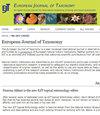萱草属植物叶表皮的特征与进化
IF 1.1
3区 生物学
Q3 ENTOMOLOGY
引用次数: 1
摘要
Amana,通常被称为“东亚郁金香”,由于最近的实地工作和系统调查,最近发现了隐藏的多样性。在这项研究中,我们从所有12种Amana中选取了64个居群,并对其表皮形态进行了显微镜观察。其叶表皮气孔分布可分为致密气孔(>10/ /视或263/mm2)、稀疏气孔(<10/ /视或263/mm2)和无气孔三种类型。其表皮细胞可分为长方形、长长方形、近长方形和菱形四种类型。表皮细胞的背斜壁形态可分为线状、波浪状和近线状混合浅波状三种类型。这些结果对阿曼属植物的分类有一定的指导意义。根据祖先特征重建分析,阿玛纳的共同祖先极有可能具有两侧有致密气孔的叶片和具有线性垂直壁的表皮细胞。本文章由计算机程序翻译,如有差异,请以英文原文为准。
Characteristics and Evolution of Leaf Epidermis in the Genus Amana Honda (Liliaceae)
Amana, commonly known as ‘East Asian tulips’, has recently been found to harbor cryptic diversity due to recent field work and systematic investigations. In this study, we included 64 populations from all 12 Amana species and performed microscopic observations of their epidermal morphology. The leaf epidermis stomatal distribution of Amana can be characterized into three types: dense stomata (>10/per view or 263/mm2), sparse stomata (<10/per view or 263/mm2), and stomata absent. The epidermal cells of Amana can be characterized into four types: rectangular, long rectangular, nearly rectangular, and rhombic. The anticlinal wall morphology of the epidermal cells can be characterized into three types: linear, wavy, and nearly linear with mixed shallow waves. All the results were helpful for classification of Amana species. According to the reconstruction of ancestral characters analyses, the common ancestor of Amana is most likely to have leaves with dense stomata on both sides, and epidermal cells that have linear vertical walls.
求助全文
通过发布文献求助,成功后即可免费获取论文全文。
去求助
来源期刊

European journal of taxonomy
ZOOLOGY-
CiteScore
2.30
自引率
8.30%
发文量
173
审稿时长
29 weeks
期刊介绍:
EJT is a fully refereed, international, fully electronic Open Access journal in descriptive taxonomy, covering subjects in zoology, entomology, botany (in its broadest sense), and palaeontology. EJT-papers must be original and adhere to high scientific (content) and technical (language, artwork, etc.) standards. Manuscripts that are clearly substandard in either of these categories will not be sent out for review. EJT is supported by a consortium of European Natural History Institutes, but its scope is global. Both authorship and geographical region of study need not be European. Authors are, however, strongly encouraged to involve European Natural History collections by consulting material or by depositing specimens (e.g. types and figured material) related to their published paper in the collection of a European Natural History Institute.
 求助内容:
求助内容: 应助结果提醒方式:
应助结果提醒方式:


